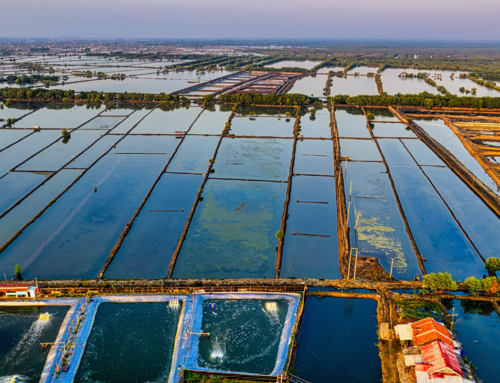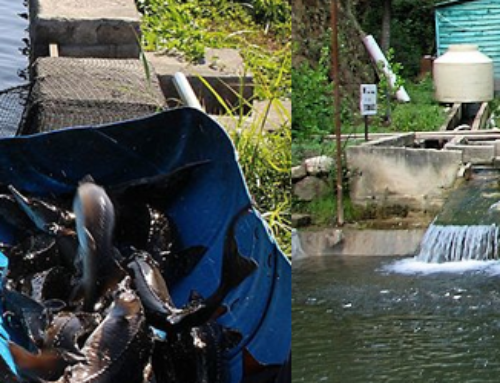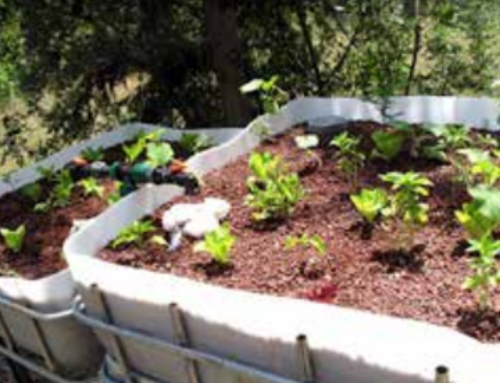In properly designed aquaponic systems, the surface area of the hydroponic component is large compared to the surface area of the fish-rearing tank (stocked at commercially relevant densities). The commercial- scale unit at UVI has a ratio of 7.3:1. The total plant growing area is 2,304 ft2 and the total fish-rearing surface area is 314 ft2.
A number of hydroponic subsystems have been used in aquaponics. Gravel hydroponic subsystems are common in small operations. To ensure adequate aeration of plant roots, gravel beds have been operated in a reciprocating (ebb and flow) mode, where the beds are alternately flooded and drained, or in a non-flooded state, where culture water is applied continuously to the base of the individual plants through small- diameter plastic tubing. Depending on its composition, gravel can provide some nutrients for plant growth (e.g., calcium is slowly released as the gravel reacts with acid produced during nitrification).
Different type of Hydroponic Subsystems
There are three basic styles of Aquaponic systems. Each system has some advantages and disadvantages and may be preferred depending on the type of culture we choose.
1- Nutrient Film Technique (NFT)
The NFT is a method commonly used in Hydroponics but is not as common in Aquaponic systems. In systems NFT, nutrient-rich water is pumped into small, enclosed gutters, the water flows in a very thin film down the gutter. Plants are placed in small plastic cups enabling their access to water and roots to absorb nutrients. The NFT is not really suitable for all types of plants, usually this will be booked to the leafy green vegetables, large plants have root systems that are too large and invasive, or they become too heavy for the gutters.
While slopes along channels of 1:100 have been recommended, in practice it is difficult to build a base for channels that is sufficiently true to enable nutrient films to flow without ponding in locally depressed areas. Therefore, it is recommended that slopes of 1:30 to 1:40 are used.
Also flow low rates for each gully should be one litre per minute (can be as low as half this and the upper limit of 2 L/min). Depressed growth rates of many crops have been observed when channels exceed 12 meters in length (channel length should not exceed 10–15 meters).
2- Deep Water Culture (DWC)
The DWC is based on the idea that plants float on top of water allowing the roots to hang in the water. This can be done in several ways. This is one of the most common commercial methods. The DWC can be implemented by floating a raft of foam on top of the aquarium, but the most common method is to have the fish in an aquarium and pump water through a filtration system, and then into long channels where there are floating rafts filled with plants on the surface of the water and the roots extract the nutrients.
3- Media Filled Beds (MFB)
- Culture beds represent the simplest form of Aquaponics. This method uses containers filled with media in place of the soil which ranges from foam to clay pebbles. Water from a fish tank is pumped into the beds of plants and the plants grown between the media and use it as a solid base. This style of system can operate in two different ways:
- A continuous stream of water running through the media filled grow bed
- Or by flooding and draining the grow bed.
Water circulation in MFB
Many configurations are possible in aquaponics, this may be as simple as a pond with floating plants above, or complex using a connection of multiple pipes and tanks. There are a few basic models that have been adopted and tested around the world with each of these styles comes its own advantages and its own disadvantages associated with them.
Continuous flow
First of all, the method of continuous flow, where the water is pumped from the fish tank to the grow bed and as is then sent back to the fish tank after moving through the grow bed. This is one of the simplest methods in Aquaponics but has some disadvantages.
Main disadvantages could include a fluctuating water level within the fish tank, a pump is required to be placed within the fish tank and not all nutrients are absorbed by plants and return to fish tank. If there is no grid of irrigation, most of the gravel will remain dry and will no longer function as a bio-filter or an area of plant growth.
Another disadvantage is that standing of water as the system requires water to travel through a small area where there will be a large blockage from plants/growth media.
A large grow bed plus a simple system of keeping all media wet is the main way to counter the disadvantages often seen within Continuous flow systems.
Flood and drain
Almost the same as a Continuous flow system. The Grow Bed lies above the aquarium; water is pumped from the aquarium to the Grow Bed; water flows back to return to the aquarium below. The only difference from the Continuous System is that the flood and drain system uses either a syphon or a standpipe to flood the Grow bed then allow it to drain.
If there is a problem with the pump or power, the water will drain whatever happens back into the aquarium. This remains the base for the majority of small urban Aquaponic farms.
By mimicking the natural cycle like the waves or tides, we can enjoy the benefits of having the Grow bed flooded and drained completely, allowing oxygen to circulate in the root zones of plants, while limiting the accumulation of solids in the bed, due to the constant action of the surging water in flooding and draining the bed of culture.
With the regular flooding of the Grow beds, there has more potential growth for plants on the bed all while reducing the absolute need for an extensive irrigation network that covers the entire surface of the bed, a definite advantage in Aquaponics.
In many trials it was found that flood and drain Aquaponics systems benefits outweigh the benefits of a flow-through system.
This does not mean that continuous flow systems do not work. Many systems with continuous stream still work perfectly as can be seen with the Aqua-farm (market leader in indoor Aquaponics).
Chift Pist
Consisting of two fish tanks and the Grow bed. Set up with one Fish tank below the Grow bed (Sump tank) and a Second fish tank reaching to the height of the Grow Bed. Water is pumped from the Sump tank into the main Fish tank. This forces the water to rise in the Tank and is sent through tubing to the Grow bed. This tubing runs to the bottom of the Main Fish tank to pick up larger solids (Known as Solids Lift Overflow). The Water that has been pumped into the Grow Bed causes it to flood and be continuously drained back into the Sump Tank below. A much harder system to design and not suitable for indoor Aquaponics.
Media for Grow Beds in Hydroponic Subsystems
 There are several types of different Media that we can use in our Aquaponics system
There are several types of different Media that we can use in our Aquaponics system
First, there is gravel, for the size of the particles it’s preferable to use gravel which are 16 mm or 20 mm, there are a few disadvantages to use different sizes.
- If the media is much smaller, then there will be not enough space for a good aeration and oxygenation of the Grow bed.
- If the Media is much larger, our surface of planting of vegetables will be significantly reduced, so it will be much more complicated to design our Aquaponics system.
Second, we have the choice often used in Hydroponics of Expanded clay pebbles.
We must be very careful about the use of Grave/Rock as they often have high mineral (e.g. Limestone) and pH levels that can prevent the uptake of nutrients by the plants and be harmful to the fish.
Media easily available for our Aquaponics System:
Types of rock available locally for us: River stones, shale, slag, and many others.
- One disadvantage is rock, or gravel media is very heavy, and we must think about this when designing our Aquaponics system and plan to have sufficient support for our Grow Beds.
- The benefits of rock media however are that it is readily available and generally very inexpensive.
- The balls of expanded clay are extremely light, neutral pH and are sold in large bags. This makes them practical to transport, store and use.
- Also Expanded Clay Pebbles are often seen as Expensive compared to Rock but for Indoor Aquaponics the Expanded Clay is still cheap with the cost only being slightly more for such a small amount needed.
Substrates (Growing Support Materials) Hydroponic Subsystems
 One of the most obvious decisions hydroponic farmers must make is which medium they should use. Different media are appropriate for different growing techniques.
One of the most obvious decisions hydroponic farmers must make is which medium they should use. Different media are appropriate for different growing techniques.
1- Expanded clay aggregate
Baked clay pellets are suitable for hydroponic systems in which all nutrients are carefully controlled in water solution. The clay pellets are inert, pH-neutral, and do not contain any nutrient value.
It is light in weight and does not compact over time.
The shape of an individual pellet can be irregular or uniform depending on brand.
Expanded clay is an ecologically sustainable and re-usable growing medium.
Expanded clay can be cleaned and sterilised, typically by washing in solutions of white vinegar, chlorine bleach, or hydrogen peroxide (H2O2), and rinsing completely.
Another view is that clay pebbles are best not re-used even when they are cleaned, due to root growth that may enter the medium. Breaking open a clay pebble after a crop has been shown to reveal this growth.
2- Growstones,
They are made from glass waste, have both more air and water retention space than perlite and peat. This aggregate holds more water than parboiled rice hulls. Growstones by volume consist of 0.5 to 5% calcium carbonate – for a standard 5.1 kg bag of Growstones that corresponds to 25.8 to 258 grams of calcium carbonate. The remainder is soda-lime glass.
3- Coconut Coir
Regardless of hydroponic demand, coconut coir is a natural byproduct derived from coconut processes. The outer husk of a coconut consists of fibers which are commonly used to make a myriad of items ranging from floor mats to brushes. After the long fibres are used for those applications, the dust and short fibers are merged to create coir. When exposed to water, the brown, dry, chunky, and fibrous material expands nearly three-four times its original size. This characteristic combined with coconut coir’s water retention capacity and resistance to pests and diseases make it an effective growth medium. Used as an alternative to rock wool, coconut coir, also known as coir peat, offers optimised growing conditions.
4- Rice husks
Parboiled rice husks (PBH) are an agricultural byproduct that would otherwise have little use. They decay over time, and allow drainage, and even retain less water than growstones. A study showed that rice husks did not affect the effects of plant growth regulators.
5- Perlite
Perlite is a volcanic rock that has been superheated into very lightweight expanded glass pebbles. It is used loose or in plastic sleeves immersed in the water. It is also used in potting soil mixes to decrease soil density. Perlite has similar properties and uses to vermiculite but, in general, holds more air and less water and is buoyant.
6- Vermiculite
Like perlite, vermiculite is a mineral that has been superheated until it has expanded into light pebbles. Vermiculite holds more water than perlite and has a natural “wicking” property that can draw water and nutrients in a passive hydroponic system. If too much water and not enough air surrounds the plants roots, it is possible to gradually lower the medium’s water-retention capability by mixing in increasing quantities of perlite.
7- Pumice stone
Like perlite, pumice is a lightweight, mined volcanic rock that finds application in hydroponics.
8- Sand
Sand is cheap and easily available. However, it is heavy, does not hold water very well, and it must be sterilised between uses. Due to sand being easily available and in high demand sand shortages are on our horizon as we are running out.
9- Wood Fibre
Wood fibre, produced from steam friction of wood, is a very efficient organic substrate for hydroponics. It has the advantage that it keeps its structure for a very long time. Wood wool (i.e., wood slivers) have been used since the earliest days of the hydroponics research. However, more recent research suggests that wood fibre may have detrimental effects on “plant growth regulators”.
10- Sheep Wool
Wool from shearing sheep is a little-used yet promising renewable growing medium. In a study comparing wool with peat slabs, coconut fibre slabs, perlite and rockwool slabs to grow cucumber plants, sheep wool had a greater air capacity of 70%, which decreased with use to a comparable 43%, and water capacity that increased from 23% to 44% with use. Using sheep wool resulted in the greatest yield out of the tested substrates, while application of a biostimulator consisting of humic acid, lactic acid, and Bacillus subtilis improved yields in all substrates.
11- Rock wool
Rock wool (mineral wool) is the most widely used medium in hydroponics. Rock wool is protected from most common microbiological degradation. Rock wool is typically used only for the seedling stage, or with newly cut clones, but can remain with the plant base for its lifetime. Rock wool has many advantages and some disadvantages.
Possibility of skin irritancy (mechanical) whilst handling (1:1000). Flushing with cold water usually brings relief. Advantages include its proven efficiency and effectiveness as a commercial hydroponic substrate.
Mineral wool products can be engineered to hold large quantities of water and air that aid root growth and nutrient uptake in hydroponics; their fibrous nature also provides a good mechanical structure to hold the plant stable.
The naturally high pH of mineral wool makes them initially unsuitable to plant growth and requires “conditioning” to produce a wool with an appropriate, stable pH.
12- Polystyrene foam peanuts
Polystyrene packing peanuts are inexpensive, readily available, and have excellent drainage. However, they can be too lightweight for some uses. They are used mainly in closed-tube systems. Note that non-biodegradable polystyrene peanuts must be used; biodegradable packing peanuts will decompose into a sludge. Plants may absorb styrene and pass it to their consumers; this is a possible health risk.




